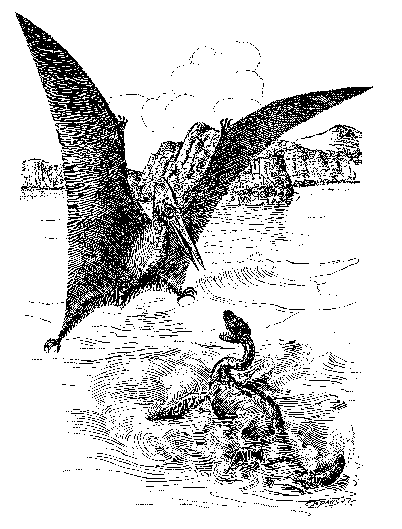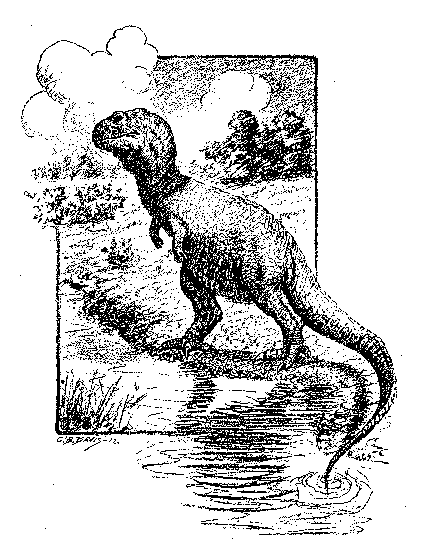
The Boy Who Never Grew Up
It's hard to imagine a world without them, but until about 150 years
ago our collective vocabularies didn't include the word
dinosaurs. The British zoologist and anatomist Richard Owen
(1804-92), one of the first great paleontologists, created the
word dinosaur by combining the Greek word deinos (terrible) with
sauros (lizard). The occasion was the 1841 conference of the
British Association for the Advancement of Science, where Owen
presented a paper that described dinosaur fossils found in Europe.
Fossils provide evidence that life has been part of Earth's history
for millions of years, and that species are born, develop, expand,
flourish, and then sometimes become extinct. The early 19th-century
French scientist Georges Cuvier (1769-1832) used the remains of
fossils to support his ideas on extinction - an uncomfortable
concept to some persons: Thomas Jefferson, for instance, thought
that too much of the world remained unexplored to be sure. He hoped
that Meriwether Lewis and William Clark would bring back evidence
of the survival of some of these "extinct" species from their
1803-1806 expedition into the new lands acquired in the Louisiana
Purchase.
Fragments of dinosaurs found in Europe hinted at a larger picture
which was eventually filled in by remarkable discoveries in the
United States. Dinosaur track-ways were abundant in Connecticut
and Massachusetts (for decades misidentified as the trackways of
giant birds or "Noah's ravens"), and the partial remains of one
dinosaur were uncovered in New Jersey in 1858. In the 1850s and
1860s, the discovery of fossils in the American West by
scientists accompanying military excursions turned the
attention of two paleontologists to the possibilities of
discoveries in Colorado and elsewhere. Othniel Charles Marsh
(1831-99) and Edward Drinker Cope (1840-97) uncovered hundreds of
new species in the sediments of the West, including the ones we
know today as Apatosaurus, Stegosaurus, and
Allosaurus. Together, Marsh and Cope named 1700 new animals and gave
the general public its first introduction to these marvelous
creatures.
Newly-founded natural history museums in the United States and Europe
began to put their accumulation of dinosaur fossils on public display
at the end of the 19th century. The size, alien shape, and sheer
antiquity of dinosaur fossils attracted wide-spread interest - and
none were more excited than the young. The early dinosaur exhibits
prompted the growth of a scientific literature designed specifically
for children. Jennie Irene Mix's Mighty Animals: Being Short Talks
about Some of the Animals Which Lived on This Earth before Man
Appeared (1912) was one of the first books to tackle paleontology
for children (the illustrations on this Web site, by C. B. Davis,
are reproduced from Mix's book). Mighty Animals, complete with
photographs of expeditions conducted by the American Museum of Natural
History in the West, discussed how dinosaurs lived and where their
fossil remains could now be found.
Dinosaurs became a fixed feature of fairs and exhibitions, a tradition
started at the London Great Exhibition in 1851. No fair would lack
dinosaurs, especially in this century. The Sinclair Oil Company began
to use a dinosaur as its logo in 1930, starting a long tradition of
life-size Sinclair models at World's Fairs such as the 1933 Century
of Progress in Chicago and the New York Fair in 1964.
The expeditions of the American Museum's Roy Chapman Andrews
(1884-1960) in Mongolia's Gobi Desert fueled a fever for dinosaurs
for several generations. Sent to the Gobi to find human ancestors,
Andrews failed; but on 23 July 1923, Andrews and his expedition
succeeded in a totally unexpected way when they found the first
large cache of dinosaur eggs ever to be discovered. Their great find
encouraged generations of paleontologists from around the world
to return to the Gobi over and over again. In his retirement,
Andrews wrote about his Gobi work in the book All About Dinosaurs
(1953), the most popular dinosaur book of all time.
The Valauskas collection has several focal points under the general
rubric of children's literature on dinosaurs. Some of the books are
here because they are early in the field. Others are present because
of the excellence of their illustrations or the imaginative
details of their production. Dinosaurs have a world-wide
audience, so there are books in Dutch, French, German, Japanese,
Lithuanian, Thai, and other languages. Some of the books shown in
The Boy Who Never Grew Up take a decidedly unscientific stance:
Valauskas is interested in any interesting dinosaurs. The Boy Who
Never Grew Up: Dinosaur Books and Realia from the Collection of
Edward J. Valauskas runs in the Dome Room of the Rotunda at the
University of Virginia, 9 am - 4:45 pm, 4 July - 15 September
1998. The exhibition was mounted by Caroline Breashears, a
doctoral student in the University of Virginia's English
Department.
The illustrations are adaptations of line drawings by C. B. Davis
that appeared in Jennie Irene Mix's 1912 book, Mighty Animals: Being
Short Talks about Some of the Animals Which Lived on This Earth
before Man Appeared (New York: American Book Company, 1912).
|
|
Email us your comments about RBS or about this web site. Last Modified: © 2005 Rare Book School at the University of Virginia |
 People around the world have encountered dinosaur remains for
thousands of years, long before Owen gave them their famous
name. Ancient Chinese experts thought that dinosaur remains proved
the existence of dragons. The Sioux Indians viewed fossils of
dinosaurs as evidence of huge serpents, struck by lightning. The
ancient Greek philosopher Theophrastus explained fossil bones as
the by-product of a plastic component in the Earth; his vis plastica
dominated thinking in the Middle Ages on fossils. Other scholars
in the Middle Ages thought that fossils were the remains of victims
of the Biblical Flood. Only in the later 19th century, with the
establishment of both geology and paleontology as scientific
disciplines, did scientists dismiss the theory that the Deluge killed
the dinosaurs.
People around the world have encountered dinosaur remains for
thousands of years, long before Owen gave them their famous
name. Ancient Chinese experts thought that dinosaur remains proved
the existence of dragons. The Sioux Indians viewed fossils of
dinosaurs as evidence of huge serpents, struck by lightning. The
ancient Greek philosopher Theophrastus explained fossil bones as
the by-product of a plastic component in the Earth; his vis plastica
dominated thinking in the Middle Ages on fossils. Other scholars
in the Middle Ages thought that fossils were the remains of victims
of the Biblical Flood. Only in the later 19th century, with the
establishment of both geology and paleontology as scientific
disciplines, did scientists dismiss the theory that the Deluge killed
the dinosaurs.
 In 1878, Belgian coal miners discovered thirty complete Iguanodon
skeletons in a shaft. Thanks to the efforts of paleontologist Louis
Dollo, these remains became the crown jewel of the Royal Museum of
Natural History in Brussels, where they drew crowds by the
thousands. Their popularity was so great that one Belgian soap
manufacturer began to put colored cards containing prehistoric scenes
into his soap packages. These cards were among the first efforts to
enlist dinosaurs as advertisers and entertainers.
In 1878, Belgian coal miners discovered thirty complete Iguanodon
skeletons in a shaft. Thanks to the efforts of paleontologist Louis
Dollo, these remains became the crown jewel of the Royal Museum of
Natural History in Brussels, where they drew crowds by the
thousands. Their popularity was so great that one Belgian soap
manufacturer began to put colored cards containing prehistoric scenes
into his soap packages. These cards were among the first efforts to
enlist dinosaurs as advertisers and entertainers.
 The materials in this
exhibition come from the collection of
The materials in this
exhibition come from the collection of